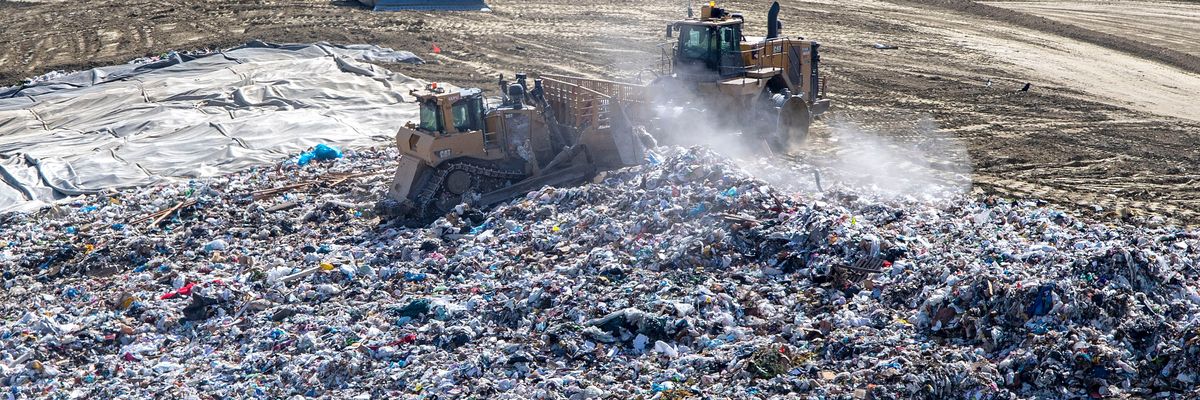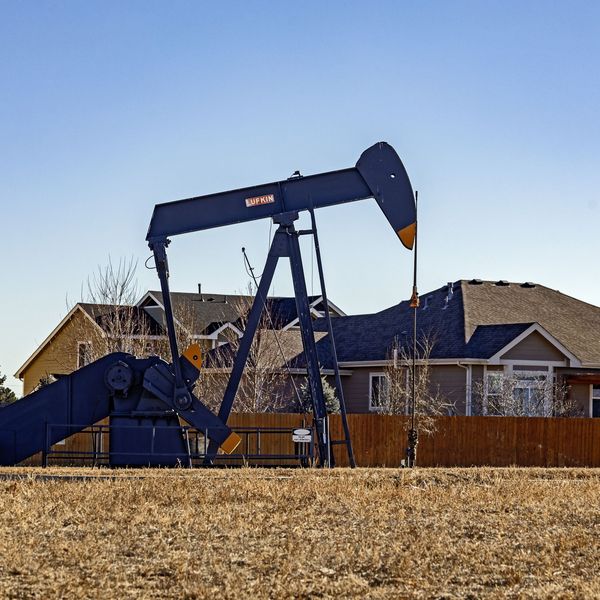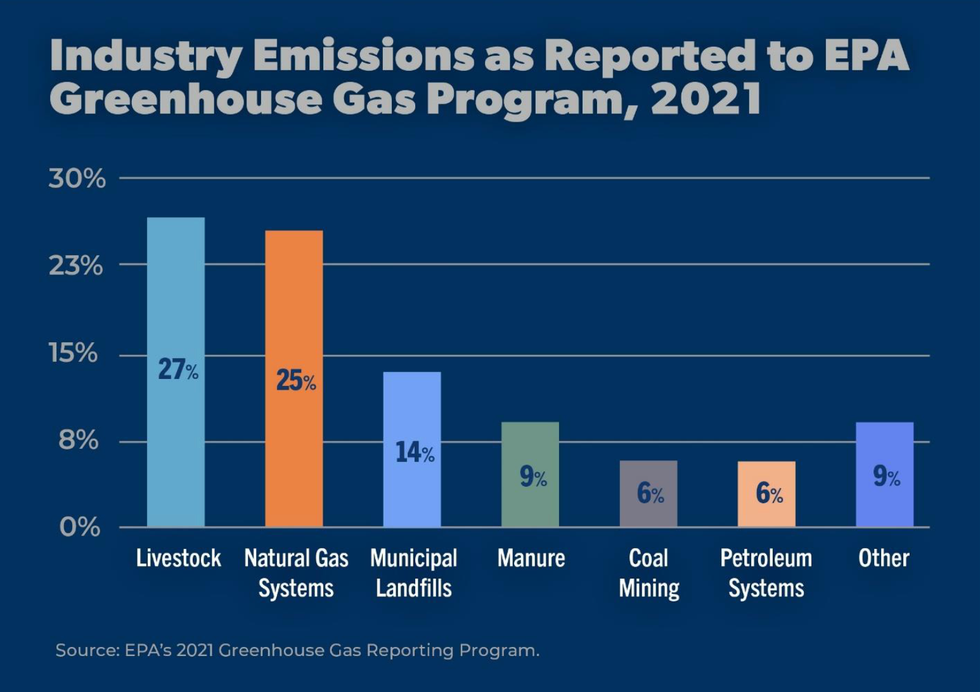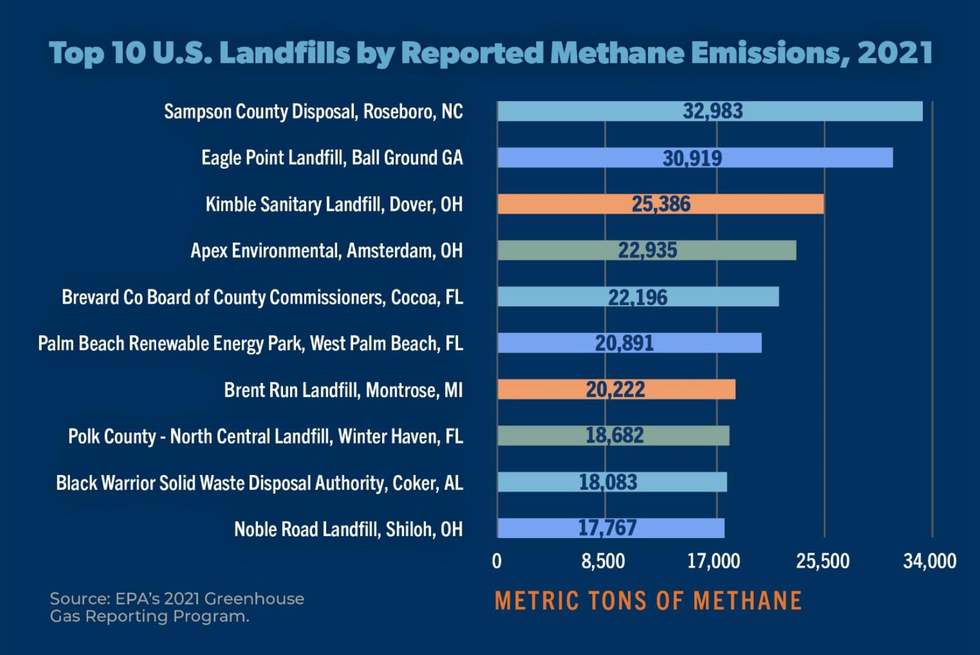
Trash is flattened and spread out across a hilllside before being covered with dirt at the Prima Deshecha landfill in San Juan Capistrano, California on Thursday, March 10, 2022.
'Trashing the Climate': EPA Failing to Address Massive Methane Emissions From Landfills
"Landfills not only contribute to climate change, but they disproportionately impact low-income neighborhoods and communities of color forced to live near dumps," said the co-author of a new report.
Methane emissions from U.S. municipal landfills—collectively, one of the nation's largest sources of the planet-heating greenhouse gas—could be reduced if the Environmental Protection Agency enacted "strong new regulations," a report released Thursday argues.
The report—entitled Trashing the Climate: Methane From Municipal Landfills—was published by the Environmental Integrity Project (EIP), a Washington, D.C.-based nonprofit. The publication notes that "more than 1,100 municipal landfills emitted at least 3.7 million metric tons of methane in 2021, which had the climate-warming impact of 66 million gasoline-powered vehicles driving for a year or 79 coal-fired power plants."
"To reduce this major but little-discussed source of potent greenhouse gases, EPA must impose regulations that mandate more gas-collection systems at landfills, require more monitoring and accurate reporting of methane emissions, and encourage more composting, recycling, and reduction in the waste stream by consumers," the paper asserts.
Methane—which has more than 80 times the warming power of carbon dioxide during its first two decades in the atmosphere—is emitted from landfills primarily due to rotting food waste. Americans throw away about 40% of their food, and U.S. food waste soared by 70% between 1990 and 2017, according to the report.
EIP also found that "municipal waste landfills are often located in communities where residents are people of color or have lower incomes."
"Fifty-four percent of the landfills reporting to EPA's greenhouse gas database are surrounded by communities, within a one-mile radius, that exceed national averages for people of color or residents considered low-income," the report notes.
\u201cA \ud83e\uddf5on how landfill methane is trashing the climate, and what we can do about it, as explored in our new report: https://t.co/vt1ShnSNnP\u201d— Environmental Integrity Project (@Environmental Integrity Project) 1684427530
The publication continues:
In Uniontown, Alabama, a community that is 98% Black and 64% below the poverty line, neighbors complain about odors, nausea, headaches, and other illnesses from a landfill that receives 93% of its garbage from out of state. In the Curtis Bay and Brooklyn neighborhoods of Baltimore, a community that is 60% Black or nonwhite Hispanic, a nearby landfill owned by the city is one of the top methane emitters in Maryland.
EIP ranked the 10 leading methane-emitting landfills in 2021, the most recent year for which data is available. Sampson County Landfill in Roseboro, North Carolina tops the list with 32,983 metric tons of methane released—more than 10 times the average landfill.
Another problem highlighted in the report is that "EPA's greenhouse gas numbers and information database are not based on pollution monitoring or sampling. Instead, all data on methane and other greenhouse gas emissions from landfills are estimated using mathematical formulas that likely lowball the real numbers."
Last year, EIP
sued the EPA, alleging the agency underreported landfill pollutant levels due to outdated estimation methods.
"EPA is failing to adequately control methane from landfills, a huge source of greenhouse gases, and we can no longer ignore this problem with the climate crisis heating up ," EIP senior attorney and report co-author Leah Kelly said in a statement Thursday. "Landfills not only contribute to climate change, but they disproportionately impact low-income neighborhoods and communities of color forced to live near dumps."
\u201c#Foodwaste = 18% of human-derived methane emissions. \n\nBut these #emissions are simple to reduce dramatically. Composting food = up to 84 percent less greenhouse gas emissions coming from landfills!\n#wastemanagement #ccac2023 #CCAC #methane #foodwaste\n\nhttps://t.co/cCjDYXQPKu\u201d— Climate & Clean Air Coalition (@Climate & Clean Air Coalition) 1684315540
In order to tackle methane pollution from landfills, the report recommends:
- EPA should issue strong new regulations that require more landfills to have methane collection systems and follow better operational standards to make sure these systems really work to reduce pollution;
- EPA should require the direct measurement of methane from landfills through new technology, including ground-based monitors and aerial monitoring systems;
- EPA should improve reporting requirements for landfills across the U.S. and establish a uniform method for estimating emissions from dumps;
- The federal government and states should encourage consumers and municipal governments to do more composting and recycling and waste less food; and
- Waste incineration should not be considered as a potential solution because it produces toxic air pollutants that tend to harm nearby low-income and minority communities.
"The U.S. must reduce landfill methane, but it must do so without increasing toxic pollution in the air that people breathe and without further threatening the health of low-income communities and communities of color," the report concludes. "Composting and improved pollution controls are solutions to the problem of landfill methane. Incineration is not a solution; it is exchanging one problem for another."
An Urgent Message From Our Co-Founder
Dear Common Dreams reader, The U.S. is on a fast track to authoritarianism like nothing I've ever seen. Meanwhile, corporate news outlets are utterly capitulating to Trump, twisting their coverage to avoid drawing his ire while lining up to stuff cash in his pockets. That's why I believe that Common Dreams is doing the best and most consequential reporting that we've ever done. Our small but mighty team is a progressive reporting powerhouse, covering the news every day that the corporate media never will. Our mission has always been simple: To inform. To inspire. And to ignite change for the common good. Now here's the key piece that I want all our readers to understand: None of this would be possible without your financial support. That's not just some fundraising cliche. It's the absolute and literal truth. We don't accept corporate advertising and never will. We don't have a paywall because we don't think people should be blocked from critical news based on their ability to pay. Everything we do is funded by the donations of readers like you. Will you donate now to help power the nonprofit, independent reporting of Common Dreams? Thank you for being a vital member of our community. Together, we can keep independent journalism alive when it’s needed most. - Craig Brown, Co-founder |
Methane emissions from U.S. municipal landfills—collectively, one of the nation's largest sources of the planet-heating greenhouse gas—could be reduced if the Environmental Protection Agency enacted "strong new regulations," a report released Thursday argues.
The report—entitled Trashing the Climate: Methane From Municipal Landfills—was published by the Environmental Integrity Project (EIP), a Washington, D.C.-based nonprofit. The publication notes that "more than 1,100 municipal landfills emitted at least 3.7 million metric tons of methane in 2021, which had the climate-warming impact of 66 million gasoline-powered vehicles driving for a year or 79 coal-fired power plants."
"To reduce this major but little-discussed source of potent greenhouse gases, EPA must impose regulations that mandate more gas-collection systems at landfills, require more monitoring and accurate reporting of methane emissions, and encourage more composting, recycling, and reduction in the waste stream by consumers," the paper asserts.
Methane—which has more than 80 times the warming power of carbon dioxide during its first two decades in the atmosphere—is emitted from landfills primarily due to rotting food waste. Americans throw away about 40% of their food, and U.S. food waste soared by 70% between 1990 and 2017, according to the report.
EIP also found that "municipal waste landfills are often located in communities where residents are people of color or have lower incomes."
"Fifty-four percent of the landfills reporting to EPA's greenhouse gas database are surrounded by communities, within a one-mile radius, that exceed national averages for people of color or residents considered low-income," the report notes.
\u201cA \ud83e\uddf5on how landfill methane is trashing the climate, and what we can do about it, as explored in our new report: https://t.co/vt1ShnSNnP\u201d— Environmental Integrity Project (@Environmental Integrity Project) 1684427530
The publication continues:
In Uniontown, Alabama, a community that is 98% Black and 64% below the poverty line, neighbors complain about odors, nausea, headaches, and other illnesses from a landfill that receives 93% of its garbage from out of state. In the Curtis Bay and Brooklyn neighborhoods of Baltimore, a community that is 60% Black or nonwhite Hispanic, a nearby landfill owned by the city is one of the top methane emitters in Maryland.
EIP ranked the 10 leading methane-emitting landfills in 2021, the most recent year for which data is available. Sampson County Landfill in Roseboro, North Carolina tops the list with 32,983 metric tons of methane released—more than 10 times the average landfill.
Another problem highlighted in the report is that "EPA's greenhouse gas numbers and information database are not based on pollution monitoring or sampling. Instead, all data on methane and other greenhouse gas emissions from landfills are estimated using mathematical formulas that likely lowball the real numbers."
Last year, EIP
sued the EPA, alleging the agency underreported landfill pollutant levels due to outdated estimation methods.
"EPA is failing to adequately control methane from landfills, a huge source of greenhouse gases, and we can no longer ignore this problem with the climate crisis heating up ," EIP senior attorney and report co-author Leah Kelly said in a statement Thursday. "Landfills not only contribute to climate change, but they disproportionately impact low-income neighborhoods and communities of color forced to live near dumps."
\u201c#Foodwaste = 18% of human-derived methane emissions. \n\nBut these #emissions are simple to reduce dramatically. Composting food = up to 84 percent less greenhouse gas emissions coming from landfills!\n#wastemanagement #ccac2023 #CCAC #methane #foodwaste\n\nhttps://t.co/cCjDYXQPKu\u201d— Climate & Clean Air Coalition (@Climate & Clean Air Coalition) 1684315540
In order to tackle methane pollution from landfills, the report recommends:
- EPA should issue strong new regulations that require more landfills to have methane collection systems and follow better operational standards to make sure these systems really work to reduce pollution;
- EPA should require the direct measurement of methane from landfills through new technology, including ground-based monitors and aerial monitoring systems;
- EPA should improve reporting requirements for landfills across the U.S. and establish a uniform method for estimating emissions from dumps;
- The federal government and states should encourage consumers and municipal governments to do more composting and recycling and waste less food; and
- Waste incineration should not be considered as a potential solution because it produces toxic air pollutants that tend to harm nearby low-income and minority communities.
"The U.S. must reduce landfill methane, but it must do so without increasing toxic pollution in the air that people breathe and without further threatening the health of low-income communities and communities of color," the report concludes. "Composting and improved pollution controls are solutions to the problem of landfill methane. Incineration is not a solution; it is exchanging one problem for another."
- New Study Confirms: Degenerative Food & Farming System Poses Mortal Threat ›
- IPCC to Say Drastic Methane Cuts Necessary to Avert Climate Hell ›
- Defusing 'Methane Bombs' Key to Averting Climate Catastrophe: Experts ›
- Potent Heat-Trapping Methane Emissions Saw 4th-Largest Annual Increase in 2022: NOAA ›
- Petition Demands EPA Take Action on 'Under-the-Radar' Methane Emissions From Landfills ›
- Just ‘Stop Drilling,’ Critics Say After Biden Admin Finalizes Methane Limits ›
- In 'Latest Pro-Polluter Move,' Trump EPA to End Emissions Data Collection | Common Dreams ›
Methane emissions from U.S. municipal landfills—collectively, one of the nation's largest sources of the planet-heating greenhouse gas—could be reduced if the Environmental Protection Agency enacted "strong new regulations," a report released Thursday argues.
The report—entitled Trashing the Climate: Methane From Municipal Landfills—was published by the Environmental Integrity Project (EIP), a Washington, D.C.-based nonprofit. The publication notes that "more than 1,100 municipal landfills emitted at least 3.7 million metric tons of methane in 2021, which had the climate-warming impact of 66 million gasoline-powered vehicles driving for a year or 79 coal-fired power plants."
"To reduce this major but little-discussed source of potent greenhouse gases, EPA must impose regulations that mandate more gas-collection systems at landfills, require more monitoring and accurate reporting of methane emissions, and encourage more composting, recycling, and reduction in the waste stream by consumers," the paper asserts.
Methane—which has more than 80 times the warming power of carbon dioxide during its first two decades in the atmosphere—is emitted from landfills primarily due to rotting food waste. Americans throw away about 40% of their food, and U.S. food waste soared by 70% between 1990 and 2017, according to the report.
EIP also found that "municipal waste landfills are often located in communities where residents are people of color or have lower incomes."
"Fifty-four percent of the landfills reporting to EPA's greenhouse gas database are surrounded by communities, within a one-mile radius, that exceed national averages for people of color or residents considered low-income," the report notes.
\u201cA \ud83e\uddf5on how landfill methane is trashing the climate, and what we can do about it, as explored in our new report: https://t.co/vt1ShnSNnP\u201d— Environmental Integrity Project (@Environmental Integrity Project) 1684427530
The publication continues:
In Uniontown, Alabama, a community that is 98% Black and 64% below the poverty line, neighbors complain about odors, nausea, headaches, and other illnesses from a landfill that receives 93% of its garbage from out of state. In the Curtis Bay and Brooklyn neighborhoods of Baltimore, a community that is 60% Black or nonwhite Hispanic, a nearby landfill owned by the city is one of the top methane emitters in Maryland.
EIP ranked the 10 leading methane-emitting landfills in 2021, the most recent year for which data is available. Sampson County Landfill in Roseboro, North Carolina tops the list with 32,983 metric tons of methane released—more than 10 times the average landfill.
Another problem highlighted in the report is that "EPA's greenhouse gas numbers and information database are not based on pollution monitoring or sampling. Instead, all data on methane and other greenhouse gas emissions from landfills are estimated using mathematical formulas that likely lowball the real numbers."
Last year, EIP
sued the EPA, alleging the agency underreported landfill pollutant levels due to outdated estimation methods.
"EPA is failing to adequately control methane from landfills, a huge source of greenhouse gases, and we can no longer ignore this problem with the climate crisis heating up ," EIP senior attorney and report co-author Leah Kelly said in a statement Thursday. "Landfills not only contribute to climate change, but they disproportionately impact low-income neighborhoods and communities of color forced to live near dumps."
\u201c#Foodwaste = 18% of human-derived methane emissions. \n\nBut these #emissions are simple to reduce dramatically. Composting food = up to 84 percent less greenhouse gas emissions coming from landfills!\n#wastemanagement #ccac2023 #CCAC #methane #foodwaste\n\nhttps://t.co/cCjDYXQPKu\u201d— Climate & Clean Air Coalition (@Climate & Clean Air Coalition) 1684315540
In order to tackle methane pollution from landfills, the report recommends:
- EPA should issue strong new regulations that require more landfills to have methane collection systems and follow better operational standards to make sure these systems really work to reduce pollution;
- EPA should require the direct measurement of methane from landfills through new technology, including ground-based monitors and aerial monitoring systems;
- EPA should improve reporting requirements for landfills across the U.S. and establish a uniform method for estimating emissions from dumps;
- The federal government and states should encourage consumers and municipal governments to do more composting and recycling and waste less food; and
- Waste incineration should not be considered as a potential solution because it produces toxic air pollutants that tend to harm nearby low-income and minority communities.
"The U.S. must reduce landfill methane, but it must do so without increasing toxic pollution in the air that people breathe and without further threatening the health of low-income communities and communities of color," the report concludes. "Composting and improved pollution controls are solutions to the problem of landfill methane. Incineration is not a solution; it is exchanging one problem for another."
- New Study Confirms: Degenerative Food & Farming System Poses Mortal Threat ›
- IPCC to Say Drastic Methane Cuts Necessary to Avert Climate Hell ›
- Defusing 'Methane Bombs' Key to Averting Climate Catastrophe: Experts ›
- Potent Heat-Trapping Methane Emissions Saw 4th-Largest Annual Increase in 2022: NOAA ›
- Petition Demands EPA Take Action on 'Under-the-Radar' Methane Emissions From Landfills ›
- Just ‘Stop Drilling,’ Critics Say After Biden Admin Finalizes Methane Limits ›
- In 'Latest Pro-Polluter Move,' Trump EPA to End Emissions Data Collection | Common Dreams ›



